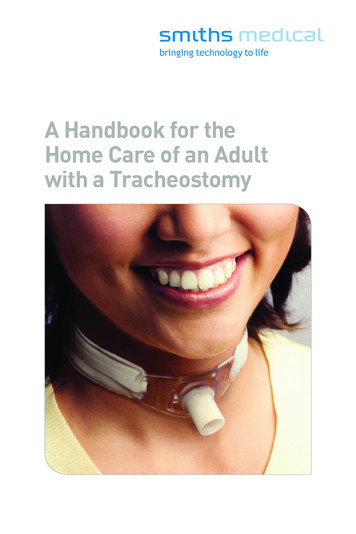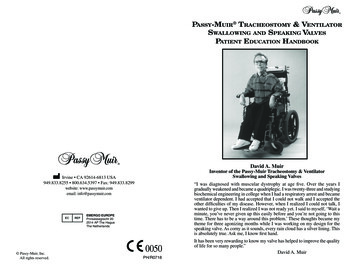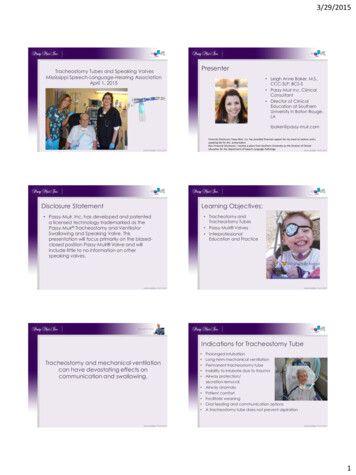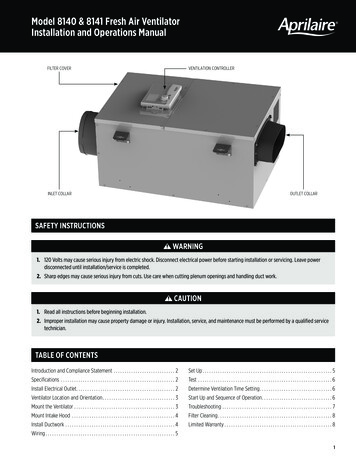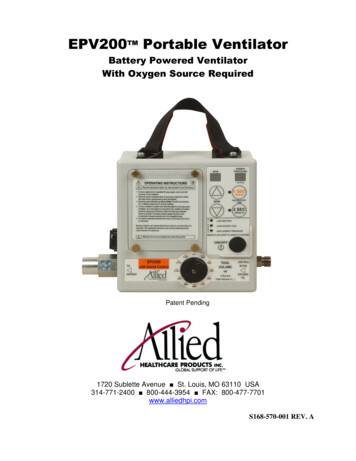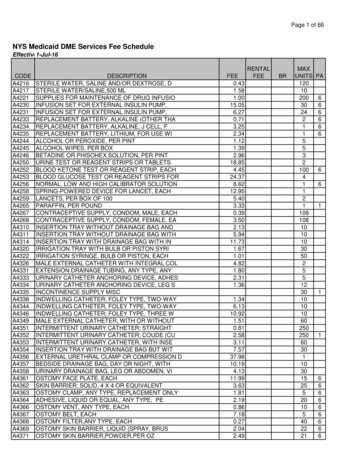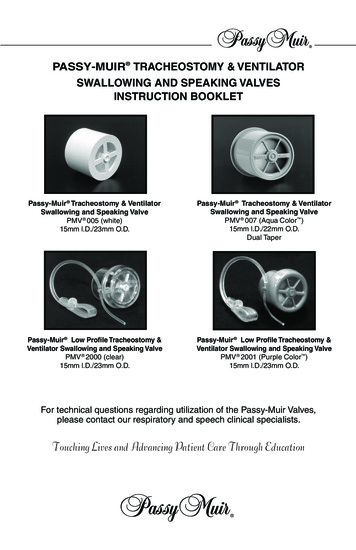
Transcription
PASSY-MUIR TRACHEOSTOMY & VENTILATORSWALLOWING AND SPEAKING VALVESINSTRUCTION BOOKLETPassy-Muir Tracheostomy & VentilatorSwallowing and Speaking ValvePMV 005 (white)15mm l.D./23mm O.D.Passy-Muir Tracheostomy & VentilatorSwallowing and Speaking ValvePMV 007 (Aqua Color )15mm l.D./22mm O.D.Dual TaperPassy-Muir Low Profile Tracheostomy &Ventilator Swallowing and Speaking ValvePMV 2000 (clear)15mm l.D./23mm O.D.Passy-Muir Low Profile Tracheostomy &Ventilator Swallowing and Speaking ValvePMV 2001 (Purple Color )15mm l.D./23mm O.D.For technical questions regarding utilization of the Passy-Muir Valves,please contact our respiratory and speech clinical specialists.Touching Lives and Advancing Patient Care Through Education
CONTENTS OF PMV PATIENT CARE KIT:This package contains one of the following Passy-Muir Tracheostomy & VentilatorSwallowing and Speaking Valves (PMVs): PMV 005 (white), PMV 007 (Aqua Color ),PMV 2000 (clear), or PMV 2001 (Purple Color ) and Instruction Booklet, PatientHandbook, PMV Storage Container, Patient Parameters Chart Label, and WarningLabels for use on the trach tube pilot line, chart and at bedside. A PMV Secure-It isalso included in the PMV 2000 (clear) and PMV 2001 (Purple Color) Patient Care Kit.The PMV 005 (white), PMV 007 (Aqua Color), PMV 2000 (clear) and PMV 2001 (Purple Color)are not made with natural rubber latex. Contents of PMV Patient Care Kit are non-sterile.READ ALL WARNINGS, PRECAUTIONS AND INSTRUCTIONSCAREFULLY PRIOR TO USE:INSTRUCTIONS FOR USEThe following instructions are applicable to the PMV 005 (white), PMV 007 (AquaColor), PMV 2000 (clear) and PMV 2001 (Purple Color) unless otherwise indicated.See additional instructions on ventilator application of the PMVs on page 10. Pleaserefer to the PMV 2020 Instruction Booklet for use of the PMV 2020.INSTRUCTIONS FOR USE OF THE PASSY-MUIR TRACHEOSTOMY & VENTILATORSWALLOWING AND SPEAKING VALVES SHOULD BE POSTED AND PROVIDED TOPATIENT AND ALL PERSONNEL INSTRUCTED IN TRACHEOSTOMY CARE.CAUTION:Federal Law (USA) restricts this device to sale by or on the orderof a physician. Store in cool, dry place.WARNING: SINGLE PATIENT USE ONLY. THIS DEVICE IS NOT DESIGNED,SOLD, OR INTENDED FOR USES EXCEPT AS INDICATED.WARNING: PATIENTS USING THE PMV MUST BE OBSERVED AND/ORMONITORED PER PHYSICIAN DIRECTION.WARNING: TRACHEOSTOMY TUBE CUFF MUST BE COMPLETELY DEFLATEDBEFORE PLACING THE PMV. PATIENT WILL BE UNABLE TO BREATHE IF CUFFIS NOT COMPLETELY DEFLATED. DO NOT USE WITH FOAM FILLED CUFFEDTRACHEOSTOMY TUBE. OBSERVE PATIENT WITH PMV IN PLACE TO ASSUREPATIENT HAS ADEQUATE AIRWAY.WARNING: DO NOT USE WITH SEVERE AIRWAY OBSTRUCTIONS SUCH ASTRACHEAL AND/OR LARYNGEAL STENOSIS. CAUTION SHOULD BE USED WITHEND STAGE PULMONARY DISEASE. DO NOT USE WITH PATIENTS WHO HAVEUNMANAGEABLE PULMONARY SECRETIONS. THIS IS NOT A DEVICE FORLARYNGECTOMIZED PATIENTS. DO NOT USE WITH ENDOTRACHEAL TUBES. DONOT USE WHILE SLEEPING.WARNING: USE CAUTION WHEN USING A PMV WITH A HEAT MOISTUREEXCHANGER (HME) DEVICE OR HYGROSCOPIC CONDENSER HUMIDIFIER (HCH).THESE DEVICES OBTAIN HUMIDITY FROM THE EXHALED BREATH OF A PATIENT.WITH THE PMV IN PLACE, AIR IS NOT EXHALED VIA THE TRACHEOSTOMY TUBEAND THIS MAY AFFECT THE PERFORMANCE OF THE HME OR HCH. ADDITIONALHUMIDIFICATION MAY BE NEEDED.CAUTION:When using a PMV 005 (white) with a tracheostomy tube that has adisposable inner cannula with grasp ring, the inner cannula may need to be removed priorto PMV placement if the grasp ring extends beyond the 15mm hub of the tracheostomytube. Failure to remove the inner cannula prior to use may obstruct opening movementof the PMV 005 (white) diaphragm.CAUTION:Remove PMV prior to delivery of medicated nebulizer treatments. If the PMVis inadvertently used during a medicated nebulizer treatment it should be removed immediatelyand rinsed thoroughly to remove medication residue as some medications may adverselyaffect the PMV diaphragm.1
DESCRIPTIONThe Passy-Muir Tracheostomy & Ventilator Swallowing and Speaking Valves(PMVs) are designed to eliminate the necessity of finger occlusion for the patientwith a tracheostomy tube while allowing the patient full-power, uninterrupted speech.The PMVs are light weight one-way closed position “no leak” valves that attach to theuniversal 15mm hub of adult, pediatric and neonatal tracheostomy tubes includingthe following: fenestrated, non-fenestrated, cuffless, metal, and air-filled cuffed withcuff completely deflated. Unlike open position one-way speaking valves, the closedposition “no leak” PMVs maintain a bias closed position except during inspiration.When the patient inhales, the PMV opens allowing air to enter the tracheostomytube and the lungs. At the end of inspiration the PMV closes automatically andremains closed throughout exhalation, without leakage. During exhalation, air isredirected around the tracheostomy tube and up through the larynx and pharynxenabling speech as the air passes through the vocal cords and through the oral andnasal cavities.The patented closed position “no leak” design creates a column of air within thetracheostomy tube that inhibits secretions from entering the tube and occluding thePMV. The bias closed position of the PMV restores the patient to a more normal closedrespiratory system. This results in the restoration of positive subglottic pressure thatfacilitates a better swallow, may reduce aspiration and facilitates a stronger, moreeffective cough that allows the patient to expectorate secretions orally.The PMVs are intended for use by both short-term and long-term adult, pediatricand neonatal tracheostomized and/or ventilator dependent patients.1All Other Speaking ValvesOpen Position SpeakingValves have Air Leak DuringExhalation and Do Not Providea Closed Respiratory System.2PMV Closed Position “No Leak” Design(1) PMVs Close Completely at End of Inhalation with No Air Leak,thereby Providing a Closed Respiratory System and More NormalBreathing Pattern. (2) Closed Position “No Leak” Design Maintains aColumn of Air in Tracheostomy Tube Redirecting Airflow and SecretionsUp the Trachea (Airway) and Out of the Mouth and/or Nose.BENEFITSThe PMVs were developed to allow tracheostomized and ventilator dependentpatients to speak more normally. However, research has validated additionalsignificant benefits with use of the PMV: Closed Position “No Leak” Design Facilitates WeaningRestores a Closed Respiratory System Expedites Decannulation Improves Speech Production Improves Olfaction Improves Swallowing and May Promotes Better HygieneReduce Aspiration Ventilator Application Facilitates Secretion Management Closed Position “No Leak” Design: Restores a more normal closed respiratorysystem which allows the patient to create positive airway pressure without theneed for manual occlusion of the tracheostomy tube.2
Speech: Tracheostomized and ventilator dependent patients can produce clearerspeech with more normal phrasing, better vocal quality and increased volume.This allows for normal development of speech and language in children. Swallowing: Use of the PMV can improve the safety and efficiency of swallowingand may reduce aspiration. A closed position valve restores the patient to a morenormal closed system which facilitates increased pharyngeal/laryngeal sensationand restores positive subglottic air pressure.WARNING: ALTHOUGH PMV USE CAN IMPROVE SWALLOWING ANDMAY REDUCE ASPIRATION IN SOME PATIENTS, THE PRESENCE AND/OR RISK OF ASPIRATION SHOULD BE EVALUATED CAREFULLY WITHEACH PATIENT TO DETERMINE APPROPRIATE USAGE OF THE PMV INADDRESSING SWALLOWING FUNCTION. Secretion Management: The closed position “no leak” design of the PMV facilitatessecretion management as it re-establishes a “closed system” that enables thepatient to produce a stronger, more effective cough and improves swallowing dueto restored positive subglottic pressure. It also facilitates evaporation of secretionsdue to redirection of air through the upper airway during exhalation. As a result,suctioning needs may be reduced. Weaning: The PMV can be used as an augmentative tool for weaning patientsfrom mechanical ventilation. The closed position “no leak” design re-establishesa more normal closed respiratory system which restores physiologic PEEP, whichcan improve oxygenation. As the patient becomes accustomed to exhaling throughthe upper airway, patient confidence is improved and respiratory muscle retrainingis facilitated. Decannulation: The PMV can be used as an alternative to tracheal tube pluggingfor patients who cannot tolerate plugging due to physiologic or emotional reasons. Ifa patient is tolerating plugging for only short periods of time, the PMV can be usedin the interim (between plugging trials) as a step to assist the patient’s transitionfrom an open tracheostomy tube to tracheal plugging. The PMV assists in thetracheostomy decannulation process by allowing the patient to begin to adjust to amore normal breathing pattern through the upper airway on exhalation. This allowsthe patient to gain confidence and the physician to assess for airway patency. Olfaction: The PMV can improve the sense of smell by re-establishing airflowthrough the oral/nasal cavities during exhalation. This improved sense of smellmay lead to an increase in sense of taste, appetite and caloric intake. Hygiene: The PMV facilitates improved tracheal hygiene. This is due to theelimination of the need for manual/finger occlusion of the tracheostomy tubewhich can lead to infections. The PMV also acts as a filter to prevent particulatesfrom entering the trachea. Secretions are redirected through the upper airwayallowing oral expectoration and reducing contamination of the environment. Ventilator Use: The PMV 005 (white), PMV 007 (Aqua Color ), PMV 2000(clear) and PMV 2001 (Purple Color ) can be used interchangeably on or off theventilator with adult, pediatric and neonatal patients.INDICATIONS FOR USEAwake and alert tracheostomized (ventilator or non-ventilator dependent)adult, pediatric and neonatal patients should be considered candidatesfor PMV use if they meet the assessment guidelines. During exhalation, airpassage must be sufficient around the tracheostomy tube and through theupper airway. The PMV is intended only for single patient use.3
INDICATIONS FOR USE CAN INCLUDE BUT ARE NOT LIMITED TO THEFOLLOWING: Ventilator DependencyNeuromuscular DiseaseQuadriplegiaHead TraumaChronic Obstructive Pulmonary DiseaseTracheomalaciaMild Tracheal and/or Laryngeal StenosisBilateral Vocal Cord Paralysis without significant airway obstructionNon-Obstructive Laryngeal Tumors (can include patients who have vocal cordfunction following surgical resection of the tumor) Sleep Apnea patients who are tracheostomized as an alternative to pluggingwhen awake Patients who emotionally or physically are unable to tolerate tracheal pluggingCONTRAINDICATIONS Unconscious and/or Comatose PatientsInflated Tracheostomy Tube CuffFoam Filled Cuffed Tracheostomy TubeSevere Airway Obstruction Which May Prevent Sufficient ExhalationThick and Copious SecretionsSeverely Reduced Lung Elasticity That May Cause Air TrappingThis Device Is Not intended For Use With Endotracheal TubesINSTRUCTIONS FOR TRACHEOSTOMIZED PATIENTSPRE-PLACEMENT ASSESSMENT GUIDELINES FOR PASSY-MUIR TRACHEOSTOMY & VENTILATOR SWALLOWING AND SPEAKING VALVESThese guidelines should be used in conjunction with physician direction:FOR TRACHEOSTOMIZED NON-VENTILATOR DEPENDENT PATIENTS, THEPMV MAY BE PLACED 48 TO 72 HOURS AFTER THE TRACHEOTOMY ISPERFORMED IF THE PATIENT’S TRACHEAL EDEMA AND/OR SECRETIONSFROM THE SURGICAL PROCEDURE HAVE DECREASED.FOR VENTILATOR DEPENDENT PATIENTS SEE VENTILATOR APPLICATIONINSTRUCTIONS.IF THE TRACHEOSTOMY TUBE HAS BEEN CHANGED, PMV PLACEMENTMAY NEED TO BE DELAYED 48-72 HOURS AS THIS PROCEDURE MAYHAVE INDUCED TRACHEAL SWELLING AND/OR BRONCHOSPASM.IT IS RECOMMENDED THAT UNIVERSAL PRECAUTIONS BE FOLLOWED.1.Cognitive Status: Patient must be awake, responsive and attempting tocommunicate. The PMV should not be used while the patient is sleeping.2.Medical/Pulmonary Status: Patient must have the appropriate lung mechanicsnecessary to exhale around the tracheostomy tube and out of the nasal andoral cavities. Patient assessment should include but is not limited to: vital signsoxygen saturationpatient reactionwork of breathingairway patencybreath soundsproper positioning of patient and tracheostomy tubepatient psychological and motivational issues4
3.Ability to Tolerate Cuff Deflation: Cuff deflation is mandatory with the PMV to allow exhaled air to pass around the tracheostomy tube and through theoronasopharynx. If it is determined that the patient cannot tolerate cuff deflationinitially (i.e., due to risk of gross aspiration or need for intensive critical controlof mechanical ventilation), the patient should be reassessed for cuff deflationas changes in his/her medical condition occur.4.Secretion Management: Use of the PMV can facilitate movement and oralexpectoration of secretions by the patient. Overabundance, viscosity and/oron-going infection affect secretion manageability. Ability to manage increasedand/or different viscosities of secretions will vary with each patient. PMV use mayneed to be limited or deferred temporarily until secretions become manageable.WARNING: PATIENTS WITH THICK UNMANAGEABLE SECRETIONSTHAT MAY CAUSE AIRWAY OBSTRUCTION SHOULD BE CAREFULLYEVALUATED FOR USE OF THE PMV.5.Swallowing: The patient’s risk for aspiration should be evaluated as this caninfluence the amount, thickness and manageability of secretions. Presenceof gross aspiration can play an important role in determining a patient’sappropriateness for cuff deflation and PMV use. The safety and efficiency of theswallowing process can be negatively affected by the presence of a tracheostomytube. While some tracheostomized individuals exhibit no swallowing difficulties,many will experience dysphagia and aspiration even though their primarydiagnosis would not typically indicate swallowing problems. Use of the PMV canimprove the safety and efficiency of swallowing and may reduce aspiration. Theclosed position “no leak” design of the PMV restores the patient to a more normalclosed system which improves swallowing as it facilitates increased pharyngeal/laryngeal sensation and restores positive subglottic air pressure.WARNING: ALTHOUGH PMV USE CAN IMPROVE SWALLOWING ANDMAY REDUCE ASPIRATION IN SOME PATIENTS, THE PRESENCE AND/OR RISK OF ASPIRATION SHOULD BE EVALUATED CAREFULLY WITHEACH PATIENT TO DETERMINE APPROPRIATE USE OF THE PMV INADDRESSING SWALLOWING FUNCTION.6.Airway Patency: The patient must be able to exhale efficiently around thetracheostomy tube, up through the larynx and pharynx and out the nasal andoral cavities in order to wear the PMV.a.Check diagnosis to ensure that there are no known airway obstructions(e.g., tumors, stenosis, granulation tissue).b.Tracheostomy tube size plays an important role in the patient’s ability toexhale efficiently. The tracheostomy tube should be sized to allow forsufficient airflow around the tracheostomy tube to facilitate speech anduse of the PMV. The cuff on a tracheostomy tube can also create anobstruction even when deflated and should be taken into considerationduring airway patency assessment. The patient with a cuffed tracheostomytube should be evaluated for a cuffless tracheostomy tube if medicallyappropriate to eliminate the need for cuff deflation with use of the PMV.c.Bedside assessment of airway patency.1. Deflate tracheostomy tube cuff completely, if present. 2. Instruct the patientto inhale through the tracheostomy tube. 3. Manually occlude the tracheostomytube with a gloved finger as you instruct the patient to exhale through themouth and nose to ensure adequate exhalation. This may be observed byhaving the patient blow on a tissue, mirror, feather, etc. Encourage the patientto vocalize (e.g., say “Ah”, count, etc.) to determine presence and quality ofvoicing. Although some patients may be able to exhale adequately, they maynot be able to vocalize initially and may require voice assessment and/orretraining. 4. Some patients may require repeated attempts of steps5
1-3 to become accustomed to exhaling through the upper airway. Upondetermination that the patient is able to exhale and/or voice adequately, youmay consider PMV placement if other assessment criteria are met.7. Lung Compliance: Critically ill and chronic pulmonary patients have lungs withaltered compliance. Therefore, PMV usage may be limited to short periods oftime during the day with close monitoring. Severe lung disease causes a lossof lung elasticity and poor natural recoil. Exhalation is thus prolonged. Carefulassessment for PMV use is needed to avoid potential complications associatedwith air trapping that can occur with non-elastic lungs. An appropriately sizedtracheostomy tube is especially crucial for these patients when consideringPMV use as it can facilitate exhaled air flow.8.Level of Care: Utilization of the PMV can occur across the continuum ofhealthcare settings. Evaluation for PMV placement can occur as early as 48‑72hours post tracheotomy. PMV placement can occur with physician order as soonas the patient has stabilized and is attempting to communicate, depending uponthe degree of tracheal edema and secretions present. Infants as young as aweek old can utilize the PMV if the assessment criteria have been met.PASSY-MUIR TRACHEOSTOMY & VENTILATOR SWALLOWING ANDSPEAKING VALVE PLACEMENTNon-Ventilator Dependent ApplicationAfter pre-assessment criteria have been met, PMV placement should occur inconjunction with a physician order using, but not limited to, the following guidelines:1.Education: To reduce anxiety and ensure successful transition to the PMV,the patient, family and all personnel (all shifts) working with the patient shouldbe instructed in the directions for use of the PMV including contraindications,cautions and warnings. Review all package inserts and labeling with patient,family and staff. Free patient information and clinical inservice videos areavailable from Passy-Muir Inc. at www.passymuir.com.2.Patient Assessment: The patient should be assessed before, during andafter PMV placement for, but not limited to, the following: Vital signs (e.g., heart rate, respiratory rate, oxygen saturation)Breath soundsChange in patient’s color and responsivenessWork of breathingTracheal and oral secretion status3.Suctioning: It is recommended that both tracheal and oral suctioning beperformed as needed. This includes before and after deflating thetracheostomy tube cuff (if present).4.Cuff Deflation: Slowly deflate the cuff of the tracheostomy tube (if present).The patient may need to be suctioned again following cuff deflation to removesecretions that were present on and/or above the cuff. The patient with acuffed tracheostomy tube should be evaluated for a cuffless tracheostomytube if medically appropriate to eliminate the need for cuff deflation with useof the PMV.WARNING: TRACHEOSTOMY TUBE CUFF MUST BE COMPLETELYDEFLATED BEFORE PLACING THE PMV. PATIENT WILL BE UNABLETO BREATHE IF CUFF IS NOT COMPLETELY DEFLATED. PMV CANNOTBE USED WITH FOAM FILLED CUFFED TRACHEOSTOMY TUBES. THEPMV CAN BE USED WITH A CUFFED TRACHEOSTOMY TUBE IF THECUFF IS COMPLETELY DEFLATED AND THE PATIENT HAS SUFFICIENTAIRFLOW AROUND THE TRACHEOSTOMY TUBE AND BULK OF THEDEFLATED CUFF.6
5.Tracheostomy Tube Size: Per physician direction, changing to a smallertracheostomy tube or cuffless tube may be needed to provide sufficient exhaledairflow to allow use of the PMV. 6.Use of Warning Labels: Attach warning labels provided with PMV to the pilotline of the patient’s cuffed tracheostomy tube and post at the patient’s bedsideand in the patient’s chart to facilitate staff awareness of proper PMV use.7.PMV Secure-It Attachment: (Applies to PMV 2000 (clear) and PMV 2001(Purple Color ) only). If using the PMV 2000 (clear) or PMV 2001 (PurpleColor) and not using them in-line with the ventilator, attach the PMV Secure-Itto the PMV prior to placing the PMV on the tracheostomy tube. Use of thePMV Secure-It which attaches to the tracheostomy tie will help to preventthe loss of the PMV if it should inadvertently come off the tracheostomy tube(e.g., during cough). Use of the PMV Secure-It is optional.a. The PMV Secure-It can be attached by threading the long tapered end ofthe PMV Secure-It through the small hole provided in the side of the PMV2000 (clear) and PMV 2001 (Purple Color) (Fig.1) and pulling it through untilit rests between the two notches (Fig. 2).b. Place the other end of the PMV Secure-It around the patient’s tracheostomytie near the neckplate of the tracheostomy tube (Fig. 3) and fasten it like abutton in a button hole (Fig. 4).WARNING: DO NOT ATTACH THE PMV SECURE-IT WHEN USING THEPMV 2000 (CLEAR) OR PMV 2001 (PURPLE COLOR) IN-LINE WITH THEVENTILATOR AS THIS MAY INTERFERE WITH DISCONNECT ALARM.c. After removing the PMV from the tracheostomy tube hub as in number 9,the PMV Secure-It (with PMV 2000 (clear) or PMV 2001 (Purple Color)only) can be removed by unbuttoning the fastener that is attached to thetracheostomy tie prior to removal of the PMV Secure-It from the PMV. PMVSecure-It can then be removed from the PMV by gently pulling it out of thesmall hole in the side of the PMV.Fig. 1Fig. 2Fig. 3Fig. 4Placement of the PMV Secure-It 8.PMV Attachment: Stabilize the tracheostomy tube with one hand while attachingthe PMV to the 15mm hub of the tracheostomy tube with the other hand usingan approximate 1/4 twist. The PMV has a friction fit for secure placement.CAUTION: Excessive force should not be used when placing thePMV 005 (white) on the tracheostomy tube as it may obstruct movement ofthe PMV diaphragm.7
9.Patient Monitoring and Removal of PMV : Observe patient to ensure thatthe diaphragm of the PMV opens during patient’s inspiration and remainsclosed during exhalation. Observe the patient with the PMV in place to ensurethe patient has adequate airflow around the tracheostomy tube. If patientexhibits signs of respiratory distress, remove PMV immediately and reassessfor airway patency.To remove PMV, stabilize the tracheostomy tube with one hand and twistPMV off gently with the other hand. If using a tracheostomy tube that has ahub that rotates, it may be necessary to use a rocking rather than twistingmotion to remove the PMV. At this time the Patient Parameters Chart Labelshould be completed and placed in the patient’s chart.WARNING: IF THE PATIENT EXPERIENCES DIFFICULTY UTILIZINGTHE PMV, THE PATIENT MAY HAVE AIRWAY OBSTRUCTION DUE TOSTENOSIS, TISSUE MASS, TRACHEOMALACIA, GRANULATION, VOCALCORD PARALYSIS IN THE MIDLINE POSITION, SECRETIONS, OR ATRACHEOSTOMY TUBE THAT IS OVERSIZED FOR THE PATIENT’STRACHEA. WITH CORRECTION OF THE OBSTRUCTION, THE PATIENTSHOULD BE RE-EVALUATED FOR PMV USE.10.Patient Transitioning: Many patients adjust immediately and easily to thePMV. However, some patients may require a gradual transition to wearingthe PMV. Some patients can tolerate the PMV during all waking hours (e.g.,16-18 hours per day). Re-education of breathing pattern and voice/speechproduction may be needed if the patient has not vocalized for a prolongedperiod of time. A Speech-Language Pathologist can assist in retraining.Patients will experience more normal respiratory sensations such as airflowin the oral/nasal chambers, and the effects of increased respiratory muscleactivity. Patients may initially experience increased coughing due to restorationof a closed respiratory system, which re-establishes subglottic pressureand normal exhaled airflow in the oral/nasal chambers. Therefore, secretionmanagement is facilitated creating movement and clearing of trachealsecretions, which aids in pulmonary hygiene. If patient exhibits prolongedexcessive coughing, PMV should be removed and airway patency should bereassessed.TROUBLESHOOTINGIf patient is unable to exhale adequately through the upper airway, the followingmay need to be considered for reassessment: Cuff Assessment: Check to ensure that the tracheostomy tube cuff iscompletely deflated. Although not required, a cuffless tracheostomy tubemay provide optimal airway patency for use with the PMV and should beconsidered if the patient is an appropriate candidate. Tracheostomy Tube Assessment: Evaluate tracheostomy tube size todetermine whether downsizing the tube is necessary due to the size of thetracheostomy tube or bulk of the deflated cuff to enable adequate exhalation. Airway Obstruction: Physician assessment (e.g., bronchoscopy) forpresence of unknown airway obstruction (e.g., stenosis, granulation, mass,vocal cord paralysis, etc.) should be considered. Positioning: Reassess to ensure optimal patient and tracheostomy tubepositioning. Patient Anxiety: Tracheostomized patients may experience anxiety with initialPMV placement. Patient education prior to placement of PMV with explanationthat the patient will experience sensation of airflow through the upper airwayupon exhalation, and may initially experience movement of secretions throughthe airway and out the mouth, may help reduce some anxiety. In addition,distraction techniques (e.g., telephone calls, family and physician visits) may8
be used to facilitate exhalation and/or voice, as well as visual techniques such as:simple spirometry or use of mirrors, cotton, feathers, whistles or bubbles. A patientinformation video featuring successful PMV users is available free of charge fromPassy-Muir Inc., which may assist in patient education and motivation.PMV CONNECTIONSFenestrated Tracheostomy Tubes: The PMV can be used with fenestrated tracheostomytubes although a fenestrated tube is NOT required. If using an inner cannula to connectthe PMV, it is necessary that both the inner and outer cannula be fenestrated to takeadvantage of the fenestration. If the fenestrated tube is cuffed, the cuff must be completelydeflated. Using the PMV with a fenestrated tube may offer the advantage of furtherimprovement in speech volume along with the other benefits of the PMV.Inner Cannula: The PMV fits on the universal 15mm hub of adult, pediatric and neonataltracheostomy tubes with a friction fit. Some tracheostomy tube designs may providethe 15mm hub as part of the inner cannula or the outer cannula. When using the PMV005 (white) on tracheostomy tubes that have a disposable inner cannula with graspring, it is necessary to ensure that the grasp ring does not extend beyond the 15 mmhub of the tracheostomy tube. If it does extend beyond the 15mm hub, the inner cannulashould be removed prior to PMV 005 (white) use.CAUTION: If the grasp ring on the inner cannula is sprung outward beyondthe 15mm hub it may obstruct movement of the PMV 005 (white) diaphragm.Premier Medical or Pilling Weck Metal Jackson Improved Tubes:Note: This instruction book is not to be used with the PMV 2020 (clear).The PMV 2020 (clear) (15mmI.D./23mm O.D.) is the only lightweight one-way closed position“no leak” valve designed to attachto the Premier Medical or PillingWeck metal Jackson Improvedtracheostomy tubes (sizes 4 - 6or equivalent) with use of thePMA 2020-S Adapter (Fig. 5a).Please contact Passy-Muir Inc. foradditional information.Adult Tube w/15mm hub15mm AdapterPMV 2020 (clear)PMA 2020-S AdapterFig. 5bFig. 5aPediatric Tubew/15mm Inner CannulaOther Metal TracheostomyTubes: Some manufacturers of metal tracheostomy tubes (pediatric and adult sizes)offer an optional inner cannula with a 15mm hub which will allow for connection of thePMVs, as well as other respiratory equipment. The inner cannula with a 15mm hub maybe ordered from the manufacturer or its distributor. A plastic endotracheal tube adaptermay be sized to a low-profile metal tracheostomy tube to create a 15mm hub that will allowfor placement of the PMV (Fig. 5b).Oxygen: Oxygen can be administered while the PMV is in placeat the tracheostomy tube site via trach collar or the Passy-Muir PMA 2000 Oxygen Adapter (Fig. 5c). Please contact Passy-MuirInc. for additional information about the PMA 2000.Humidity: Humidity (non-medicated heated aerosol) can beapplied at the tracheostomy tube site with the PMV in place viathe use of a trach collar.PMA 2000 Oxygen Adapteron thePMV 2001 (Purple Color )Fig. 5cWARNING: USE CAUTION WHEN USING A PMV WITH A HEAT MOISTUREEXCHANGER (HME) DEVICE OR HYGROSCOPIC CONDENSER HUMIDIFIER(HCH). THIS DEVICE OBTAINS HUMIDITY FROM THE EXHALED BREATHOF A PATIENT. WITH THE PMV IN PLACE, AIR IS NOT EXHALED VIA THETRACHEOSTOMY TUBE AND THIS MAY AFFECT THE PERFORMANCE OFTHE HME. ADDITIONAL HUMIDIFICATION MAY BE NEEDED.CAUTION: Remove PMV prior to delivery of medicated nebulizer treatments.If the PMV is inadvertently used during a medicated nebulizer treatment it shouldbe removed immediately and rinsed thoroughly to remove medication residueas some medications may adversely affect the PMV diaphragm.9
INSTRUCTIONS FOR VENTILATOR APPLICATIONWhen using PMVs with ventilator dependent patients all previous instructions,warnings and cautions should be carefully reviewed and incorporated withthe following ventilator application guidelines:The PMV 005 (white), PMV 007 (Aqua Color ), PMV 2000 (clear) and the PMV2001 (Purple Color ) can be used with acute care and portable ventilators andin conjunction with most conventional modes of ventilation.The PMV 005 (white), PMV 007 (Aqua Color), PMV 2000 (clear) and PMV2001 (Purple Color) can be used interchangeably on or off the ventilatordepending upon the type of ventilator tubing. The PMV 005 (white), PMV 2000(clear) and the PMV 2001 (Purple Color) have a 23mm outer diameter (O.D.)and must be used with short, wide mouth, flexible, non-disposable (rubber)ventilator tubing. The PMV 007 (Aqua Color), which has a 22mm O.D., isdesigned to fit directly into disposable ventilator tubing and can also be used
Hygiene: The PMV facilitates improved tracheal hygiene. This is due to the elimination of the need for manual/finger occlusion of the tracheostomy tube which can lead to infections. The PMV also acts as a filter to prevent particulates from entering the trachea. Secretions are redirected through the upper airway
